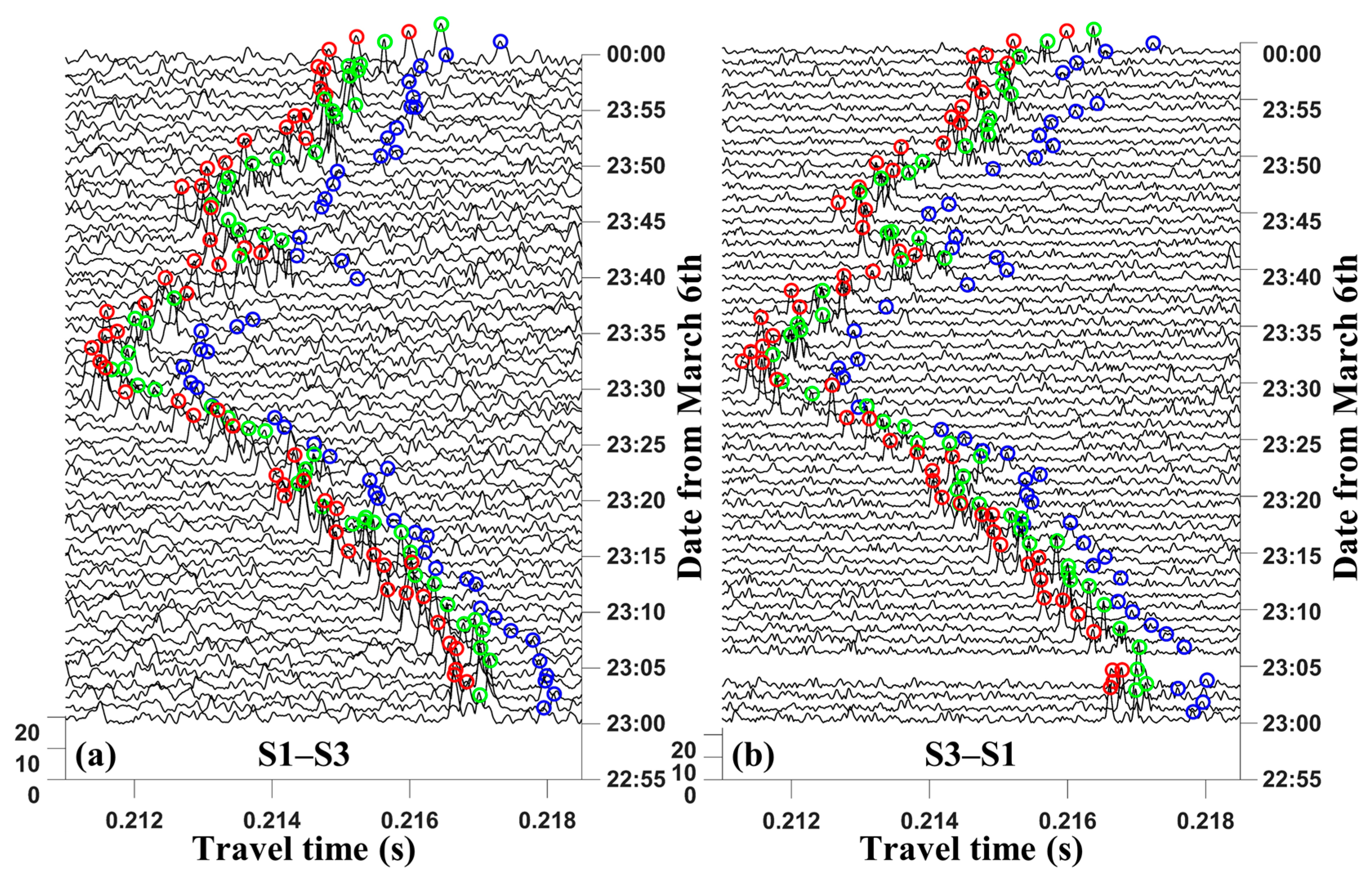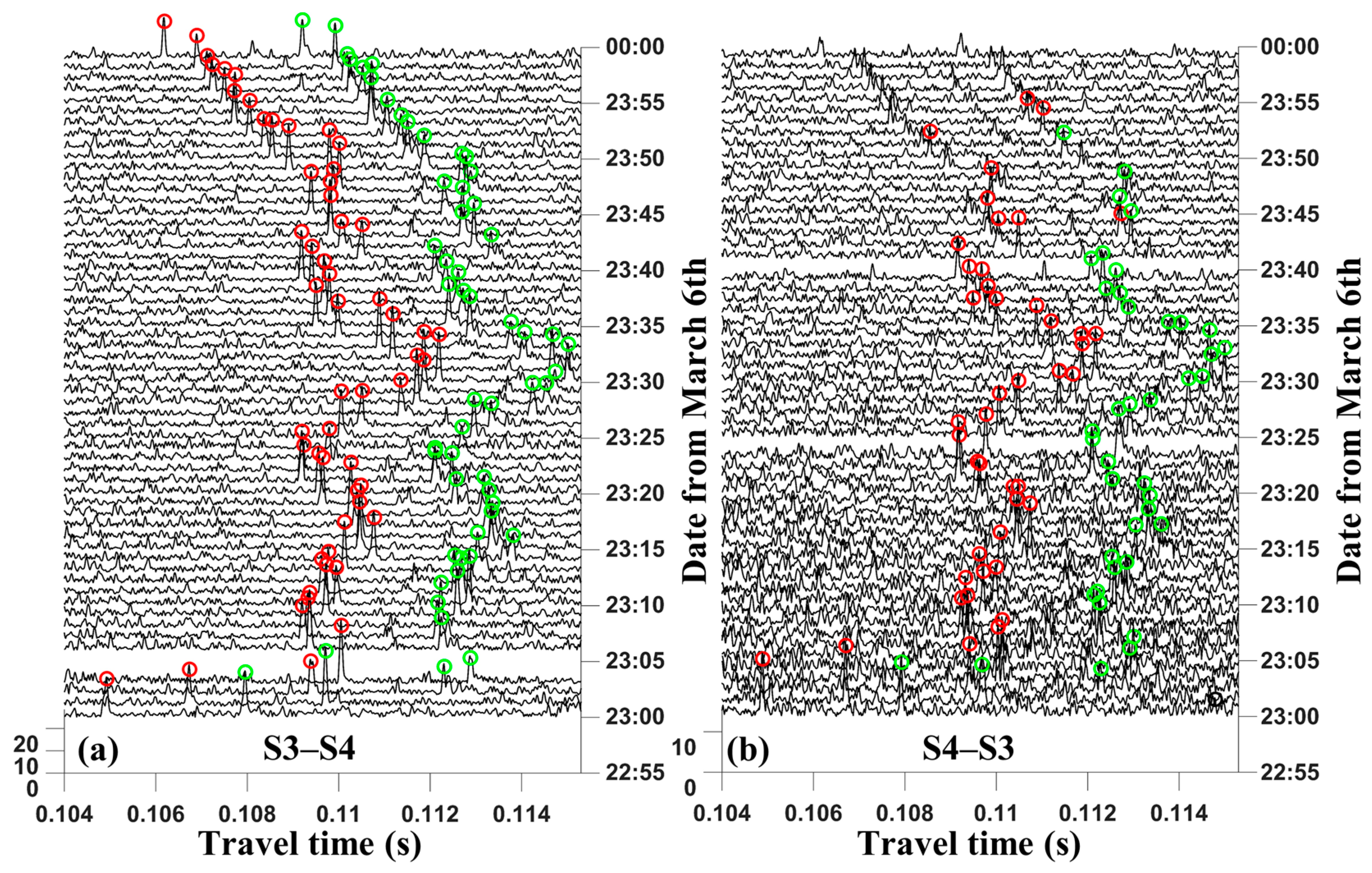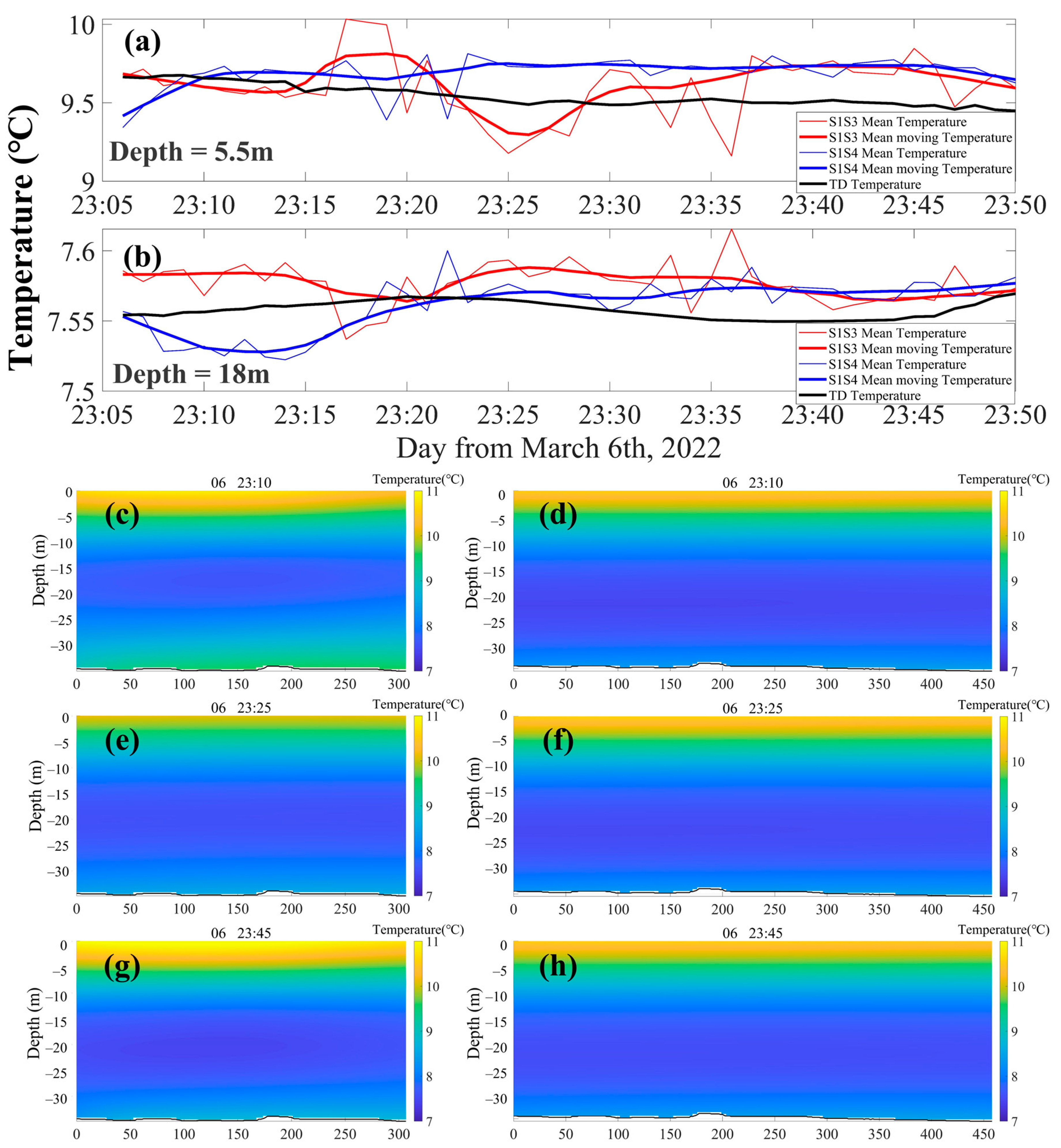Water Temperature Reconstruction via Station Position Correction Method Based on Coastal Acoustic Tomography Systems
Abstract
:1. Introduction
2. Methodology
2.1. Direct Signal Transmission Correction
2.2. Ray-Model Position Correction
3. Experiment
4. Results
4.1. Multi-Peak Identification and Matching
4.2. Travel Time Correction
4.3. Inversion Result
5. Discussion and Conclusions
6. Conclusions
- Two methods for travel time error caused by station position drift are developed and verified. The standard deviation of corrected data is around 0.15 ms, and uncorrected data is about 1.5 ms. Thus, the quality of 2D vertical water temperature variations is improved 90% via new methods.
- A two-dimensional vertical water temperature profile among three stations is successfully established by the corrected travel time data, and the errors of the inversion results are within the experience requirements.
- The correction methods have improved the initial data and can be attempted for further water environment observation in acoustic tomography observation studies.
Author Contributions
Funding
Data Availability Statement
Acknowledgments
Conflicts of Interest
References
- Munk, W.; Wunsch, C. Ocean acoustic tomography—Scheme for large-scale monitoring. Deep. Sea Res. Part A Oceanogr. Res. Pap. 1979, 26, 123–161. [Google Scholar] [CrossRef]
- Kaneko, A.; Zhu, X.H.; Lin, J. Coastal Acoustic Tomography; Elsevier Science Bv: Amsterdam, The Netherlands, 2020; pp. 1–347. [Google Scholar]
- Al Sawaf, M.B.; Kawanisi, K.; Gusti, G.N.N.; Khadami, F.; Xiao, C.; Bahreinimotlagh, M. Continuous measurement of flow direction and streamflow based on travel time principles using a triangular distribution of acoustic tomography systems. J. Hydrol. 2023, 617, 128917. [Google Scholar] [CrossRef]
- Gusti, G.N.N.; Kawanisi, K.; Al Sawaf, M.B.; Khadami, F. Subtidal Dynamics in a Tidal River with Limited Discharge. Water 2022, 14, 2585. [Google Scholar] [CrossRef]
- Syamsudin, F.; Taniguchi, N.; Zhang, C.; Hanifa, A.D.; Li, G.; Chen, M.; Mutsuda, H.; Zhu, Z.N.; Zhu, X.H.; Nagai, T. Observing internal solitary waves in the Lombok Strait by coastal acoustic tomography. Geophys. Res. Lett. 2019, 46, 10475–10483. [Google Scholar] [CrossRef] [Green Version]
- Syamsudin, F.; Adityawarman, Y.; Sulistyowati, R.; Sutedjo, B.; Kaneko, A.; Goda, N. Applicability and feasibility studies of coastal acoustic tomography for long-term monitoring of the Indonesian throughflow transport variability. J. Acoust. Soc. Am. 2016, 140, 3076. [Google Scholar] [CrossRef]
- Huang, H.C.; Guo, Y.; Wang, Z.K.; Shen, Y.; Wei, Y. Water Temperature Observation by Coastal Acoustic Tomography in Artificial Upwelling Area. Sensors 2019, 19, 2655. [Google Scholar] [CrossRef] [PubMed] [Green Version]
- Zhu, Z.N.; Zhu, X.H.; Guo, X.; Fan, X.; Zhang, C. Assimilation of coastal acoustic tomography data using an unstructured triangular grid ocean model for water with complex coastlines and islands. J. Geophys. Res. Ocean. 2017, 122, 7013–7030. [Google Scholar] [CrossRef]
- Zhu, Z.-N.; Zhu, X.-H.; Guo, X. Coastal tomographic mapping of nonlinear tidal currents and residual currents. Cont. Shelf Res. 2017, 143, 219–227. [Google Scholar] [CrossRef]
- Zhu, Z.-N.; Zhu, X.-H.; Zhang, C.; Chen, M.; Zheng, H.; Zhang, Z.; Zhong, J.; Wei, L.; Li, Q.; Wang, H. Monitoring of Yangtze River Discharge at Datong Hydrometric Station Using Acoustic Tomography Technology. Front. Earth Sci. 2021, 9, 723123. [Google Scholar] [CrossRef]
- Xiao, C.; Kawanisi, K.; Torigoe, R.; Al Sawaf, M.B. Mapping tidal current and salinity at a shallow tidal channel junction using the fluvial acoustic tomography system. Estuar. Coast. Shelf Sci. 2021, 258, 15. [Google Scholar] [CrossRef]
- Zhang, C.Z.; Kaneko, A.; Zhu, X.H.; Gohda, N. Tomographic mapping of a coastal upwelling and the associated diurnal internal tides in Hiroshima Bay, Japan. J. Geophys. Res.-Ocean. 2015, 120, 4288–4305. [Google Scholar] [CrossRef]
- Zhang, C.Z.; Zhu, X.H.; Zhu, Z.N.; Liu, W.H.; Zhang, Z.Z.; Fan, X.P.; Zhao, R.X.; Dong, M.H.; Wang, M. High-precision measurement of tidal current structures using coastal acoustic tomography. Estuar. Coast. Shelf Sci. 2017, 193, 12–24. [Google Scholar] [CrossRef]
- Dai, L.; Xiao, C.; Zhu, X.-H.; Zhu, Z.-N.; Zhang, C.; Zheng, H.; Chen, M.; Li, Q. Tomographic Reconstruction of 3D Sound Speed Fields to Reveal Internal Tides on the Continental Slope of the South China Sea. Front. Mar. Sci. 2023, 9, 2823. [Google Scholar] [CrossRef]
- Huang, C.F.; Li, Y.W.; Taniguchi, N. Mapping of ocean currents in shallow water using moving ship acoustic tomography. J. Acoust. Soc. Am. 2019, 145, 858–868. [Google Scholar] [CrossRef] [PubMed]
- Zheng, H.; Gohda, N.; Noguchi, H.; Ito, T.; Yamaoka, H.; Tamura, T.; Takasugi, Y.; Kaneko, A. Reciprocal sound transmission experiment for current measurement in the Seto Inland Sea, Japan. J. Oceanogr. 1997, 53, 117–128. [Google Scholar]
- Medwin, H. Speed of sound in water: A simple equation for realistic parameters. J. Acoust. Soc. Am. 1975, 58, 1318–1319. [Google Scholar] [CrossRef]
- Zhu, X.H.; Kaneko, A.; Wu, Q.S.; Zhang, C.Z.; Taniguchi, N.; Gohda, N. Mapping Tidal Current Structures in Zhitouyang Bay, China, Using Coastal Acoustic Tomography. IEEE J. Ocean. Eng. 2013, 38, 285–296. [Google Scholar] [CrossRef]
- Xu, S.J.; Xue, Z.; Xie, X.Y.; Huang, H.C.; Li, G.M. Layer-Averaged Water Temperature Sensing in a Lake by Acoustic Tomography with a Focus on the Inversion Stratification Mechanism. Sensors 2021, 21, 7448. [Google Scholar] [CrossRef]
- Xu, S.; Li, G.; Feng, R.; Hu, Z.; Xu, P.; Huang, H. Tomographic Mapping of Water Temperature and Current in a Reservoir by Trust-Region Method Based on CAT. IEEE Trans. Geosci. Remote Sens. 2022, 60, 4211314. [Google Scholar] [CrossRef]
- Huang, H.C.; Xu, S.J.; Xie, X.Y.; Guo, Y.; Meng, L.W.; Li, G.M. Continuous Sensing of Water Temperature in a Reservoir with Grid Inversion Method Based on Acoustic Tomography System. Remote Sens. 2021, 13, 2633. [Google Scholar] [CrossRef]
- Monforte, P.; Ragusa, M.A. Temperature Trend Analysis and Investigation on a Case of Variability Climate. Mathematics 2022, 10, 2202. [Google Scholar] [CrossRef]
- Mendoza, V.; Pazos, M.; Garduño, R.; Mendoza, B. Thermodynamics of climate change between cloud cover, atmospheric temperature and humidity. Sci. Rep. 2021, 11, 21244. [Google Scholar] [CrossRef] [PubMed]









| Initial | ||||||
| Multi-peak | 1st peak | 2nd peak | 3rd peak | |||
| Station pair | S1–S3 | S3–S1 | S1–S3 | S3–S1 | S1–S3 | S3–S1 |
| Standard deviation of initial (ms) | 1.4985 | 1.4969 | 1.4841 | 1.4969 | 1.4639 | 1.525 |
| Correction | ||||||
| Station pair | S1–S3 | S3–S1 | S1–S3 | S3–S1 | S1–S3 | S3–S1 |
| Standard deviation of RMC (ms) | 0.2332 | 0.2316 | 0.1028 | 0.1359 | 0.1677 | 0.1777 |
| Standard deviation of DSC (ms) | / | / | 0.1019 | 0.166 | 0.1347 | 0.1764 |
Disclaimer/Publisher’s Note: The statements, opinions and data contained in all publications are solely those of the individual author(s) and contributor(s) and not of MDPI and/or the editor(s). MDPI and/or the editor(s) disclaim responsibility for any injury to people or property resulting from any ideas, methods, instructions or products referred to in the content. |
© 2023 by the authors. Licensee MDPI, Basel, Switzerland. This article is an open access article distributed under the terms and conditions of the Creative Commons Attribution (CC BY) license (https://creativecommons.org/licenses/by/4.0/).
Share and Cite
Xu, P.; Xu, S.; Yu, F.; Gao, Y.; Li, G.; Hu, Z.; Huang, H. Water Temperature Reconstruction via Station Position Correction Method Based on Coastal Acoustic Tomography Systems. Remote Sens. 2023, 15, 1965. https://doi.org/10.3390/rs15081965
Xu P, Xu S, Yu F, Gao Y, Li G, Hu Z, Huang H. Water Temperature Reconstruction via Station Position Correction Method Based on Coastal Acoustic Tomography Systems. Remote Sensing. 2023; 15(8):1965. https://doi.org/10.3390/rs15081965
Chicago/Turabian StyleXu, Pan, Shijie Xu, Fenyuan Yu, Yixin Gao, Guangming Li, Zhengliang Hu, and Haocai Huang. 2023. "Water Temperature Reconstruction via Station Position Correction Method Based on Coastal Acoustic Tomography Systems" Remote Sensing 15, no. 8: 1965. https://doi.org/10.3390/rs15081965
APA StyleXu, P., Xu, S., Yu, F., Gao, Y., Li, G., Hu, Z., & Huang, H. (2023). Water Temperature Reconstruction via Station Position Correction Method Based on Coastal Acoustic Tomography Systems. Remote Sensing, 15(8), 1965. https://doi.org/10.3390/rs15081965






